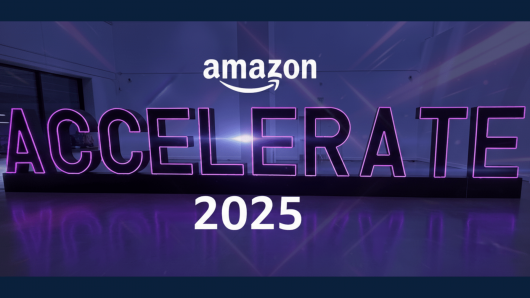Each year, Amazon Accelerate serves as the marquee event where Amazon outlines its vision for the future of e-commerce. The 2025 edition made one thing unmistakably clear: the AI revolution isn’t coming, it’s here, it’s accelerating, and it’s reshaping how brands sell, advertise, and fulfill on the world’s largest marketplace.
From agentic AI tools that act like proactive business partners, to expanded fulfillment capabilities that turn Amazon into a logistics backbone for the entire industry, this year’s announcements signal structural shifts. What was once optional is quickly becoming table stakes. Sellers, agencies, and partners who adapt quickly will find themselves riding a wave of opportunity, and those who lag may struggle to keep up.
In this recap, we’ll walk through the major themes, highlight the most important announcements from Amazon Accelerate, and break down what they mean for brands and advertisers.
A Year of Seller Growth
Before diving into new tools and features, Amazon spotlighted platform momentum: 55,000 sellers surpassed $1M+ in sales last year, underscoring the platform’s role as a growth engine for entrepreneurs and brands of all sizes.
This continued expansion provides room for Amazon to invest in new technologies, especially AI, that help sellers scale responsibly while maintaining customer trust.
Agentic AI: A Seller’s Always-On Assistant
The headline announcement at Accelerate 2025 was the rollout/upgrade of Amazon’s Seller Assistant, powered by agentic AI. Unlike past automation tools, this assistant doesn’t just react to prompts; it can proactively manage tasks, diagnose issues, and propose actions, all while leaving the final decision with the seller.
What Agentic AI Can Do:
- Account Health & Compliance: The assistant can resolve complex account issues, even notorious issues like pesticide claims, while monitoring compliance in real time.
- Inventory & Promotions: It can assess fees, run sales with different goals, prepare full Prime Day plans based on past data, and surface growth opportunities.
- Diagnostics & Fixes: If sales drop, the assistant can analyze whether it’s due to pricing, promotions, or advertising and suggest corrective actions.
- Global Expansion: It also supports cross-border growth by streamlining operational complexity.
Essentially, Amazon is offering sellers a true business partner in AI form – one that promises to save time, reduce stress, and free leaders to focus on strategy.
Creative AI: Advertising Without Barriers
On the advertising front, Amazon doubled down on Creative AI, with tools designed to make professional-grade creative accessible to every brand.
Key Announcements:
- AI-Generated A+ Content & Video Ads: Sellers can now instantly generate branded content, images, and videos.
- Amazon AI Studio: A creative agent system that analyzes a brand and its competitors, then generates fresh assets.
- Unlimited A/B Testing: Brands can iterate faster, with AI helping refine concepts, storyboards, and even music.
- AI Persona Builder & Review Analysis: Tools that create realistic customer personas and highlight top pain points from reviews, giving brands immediate insight into what matters most.
Early adopters of Amazon’s Creative AI reported a 12% sales lift in just one month, proof that lowering barriers to quality creative can directly drive performance.
For agencies and advertisers, this easy access to creative means strategy and storytelling become even more critical. If everyone has access to polished visuals, differentiation will come from insight, positioning, and execution.
Data & Analytics: Insights for All
Another major shift was the expansion of Amazon Marketing Cloud (AMC). Once gated, AMC is now open to all sellers running Sponsored Products, marking a huge leap in access to first-party data.
Why It Matters:
- First-Party Advantage: As privacy regulations tighten, AMC gives brands a reliable source of truth on shopper behavior.
- Custom Dashboards & Profit GPS: New tools allow brands to consolidate metrics, run scenario planning, and even flag “excess costs” where spend is wasted.
- Customer Journey Analytics: At the ASIN level, brands can diagnose keyword performance, detect product downturns, and make informed adjustments.
This parallels trends we’ve seen with Google and Meta: data is being centralized, cleaned, and offered through secure environments. The playing field is leveling, but the winners will be those who know how to turn data into action.
Fulfillment & Logistics: Amazon Becomes a Backbone
Outside of AMC, the most disruptive announcements came in the realm of fulfillment and supply chain. Amazon signaled its ambition to move beyond marketplace operations and become the logistics infrastructure powering e-commerce everywhere.
Key Developments:
- End of Inventory Commingling: A long-standing seller complaint is finally being addressed. Products from different sellers will no longer be lumped together, protecting brand quality and reducing counterfeit risk.
- Returns & Reimbursements Improvements: Faster processing, partial refunds, and real-time support upgrades cut down on friction.
- Multi-Channel Fulfillment (MCF) Expansion: Sellers can now use Amazon’s network to fulfill orders from Walmart, eBay, TikTok Shop, Temu, Shopify, and SHEIN. Delivery speed is improving from five days to approximately three, with no cost increase.
- Global Inventory Pool: Sellers can ship directly from manufacturing locations, reducing cross-border logistics costs by 20% to 40%.
- Amazon Managed Service: Early adopters report 30% fewer stockouts, 10% more one-day deliveries, and up to 20% higher sales.
Amazon is no longer just competing for marketplace dominance; it’s positioning itself to be the logistics backbone of retail, much like AWS is the backbone of cloud computing.
Product Launches & Growth Tools
Amazon also announced a host of product discovery and launch support initiatives designed to help brands bring new offerings to market faster:
- Opportunity Explorer: AI identifies unmet demand, generates product proposals, and even plugs into external AI tools for deeper insights.
- Lower Launch Costs: New programs waive storage fees, offer liquidation at no cost for the first 180 days, and provide regional launch options to test small before scaling.
- Early Review Acceleration: Vine is now available before inventory hits FBA, improving your launch timeline. AI has also improved reviewer matching, helping brands get to social proof faster.
These programs reduce barriers for innovation, allowing brands to test, learn, and iterate with less financial risk.
B2B Momentum
While consumer sales dominate headlines, Amazon Business continues to quietly scale:
- Over eight million businesses now purchase through the platform.
- B2B orders average 70% more units with 40% fewer returns.
- Amazon is offering exclusive ad formats for B2B sellers, which have delivered two to three times stronger returns than consumer-focused ads.
This signals a significant opportunity for brands serving both consumer and business segments to diversify revenue streams.
Strategic Implications: What This Means for Brands
With so many announcements, it can be easy to feel overwhelmed. But viewed holistically, the message from Accelerate 2025 is clear:
- AI Is Table Stakes. From compliance to creative, AI will soon be embedded in every aspect of selling. Brands that embrace it early will gain efficiency and insight advantages.
- Creative Differentiation Matters More Than Ever. With barriers to quality production falling, success depends on sharp positioning, authentic storytelling, and cohesive cross-channel strategies.
- Data Is Becoming More Accessible. The expansion of AMC means even small sellers can play with enterprise-grade insights. The challenge lies in execution, not access.
- Fulfillment Is the Next Battleground. As Amazon opens MCF to competitors like Walmart, the line between marketplace and logistics provider blurs. Brands must rethink distribution strategies accordingly.
Amazon Accelerate 2025 will likely be remembered as the year AI moved from buzzword to backbone. The announcements spanned the seller journey end-to-end: from product development and compliance, to creative, to advertising, to logistics.
For brands and agencies, the challenge now is not simply staying informed. It’s moving fast enough to test, adopt, and scale these innovations in ways that drive real business value.
If the past year was about experimentation, the year ahead will be about execution. Those who lean into Amazon’s new tools with clear strategies will find themselves positioned for exponential growth.








